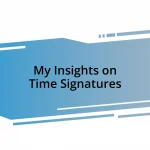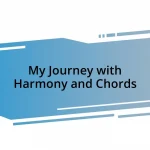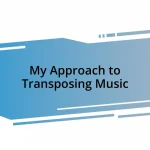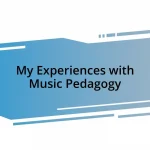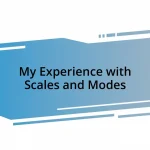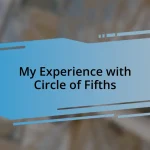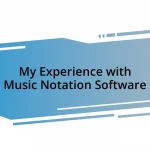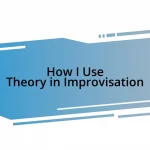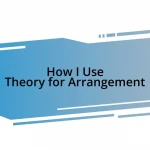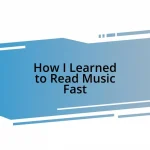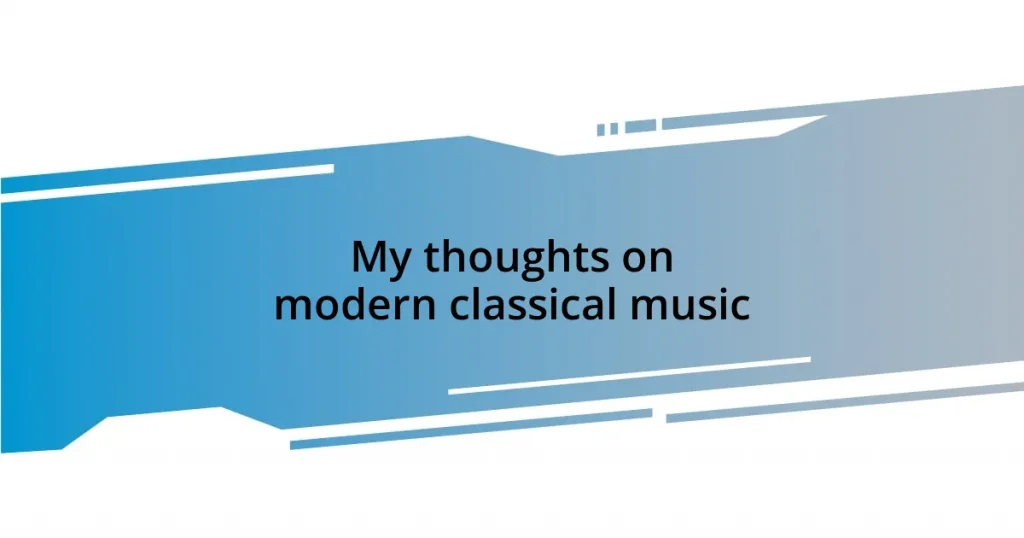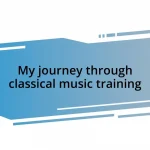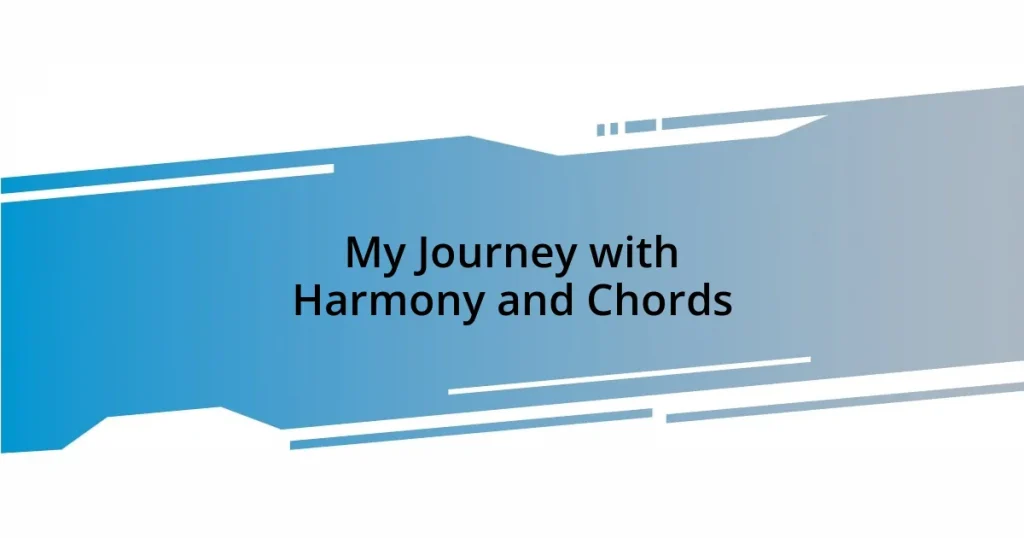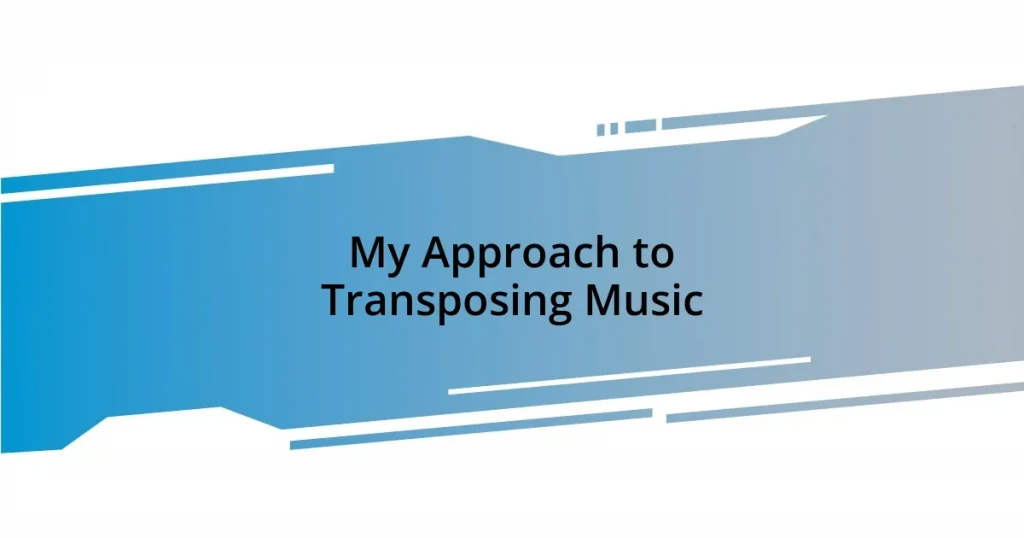Key takeaways:
- Modern classical music challenges traditional forms by blending genres and employing innovative techniques, such as the use of technology in composition.
- Contemporary music focuses on raw emotions and personal connections, often utilizing silence to create depth and tension within compositions.
- Performance practices have evolved, incorporating unconventional spaces and multimedia elements, enhancing the audience’s experience and engagement.
- Notable modern works include Max Richter’s Sleep, Ólafur Arnalds’ re:member, and Philip Glass’s The Hours, each offering profound emotional and introspective journeys.
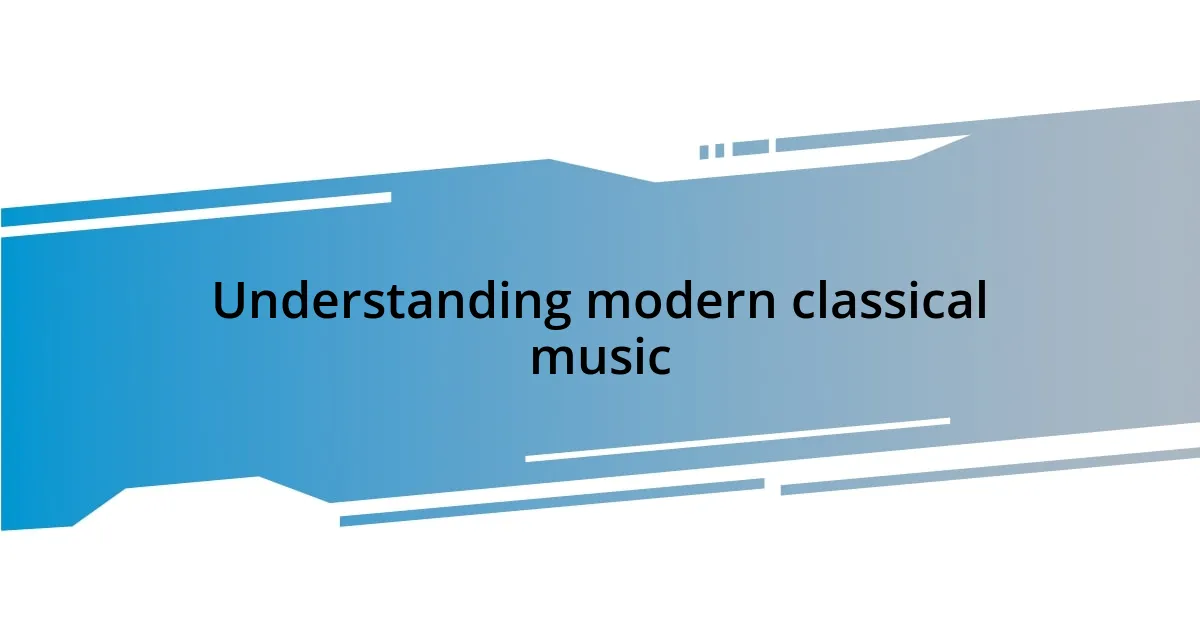
Understanding modern classical music
Modern classical music is a fascinating realm that often challenges our perceptions. I remember the first time I attended a contemporary concert; the dissonance in the music felt jarring yet exhilarating. It made me wonder—how do we define beauty in sound?
One key aspect of understanding modern classical music is its departure from traditional forms. Composers today frequently experiment with rhythm, structure, and instrumentation, blending genres in ways that can be unexpected. For example, I once heard a piece that combined electronic elements with live strings—it was a compelling reminder that boundaries in music are meant to be pushed.
I think many listeners initially feel perplexed when they encounter this genre. The absence of familiar melodies can be disorienting. Yet, I’ve found that allowing myself to immerse in the unfamiliar often leads to revelations and deeper emotional connections. Isn’t it fascinating how music can evolve and still speak to the human experience?
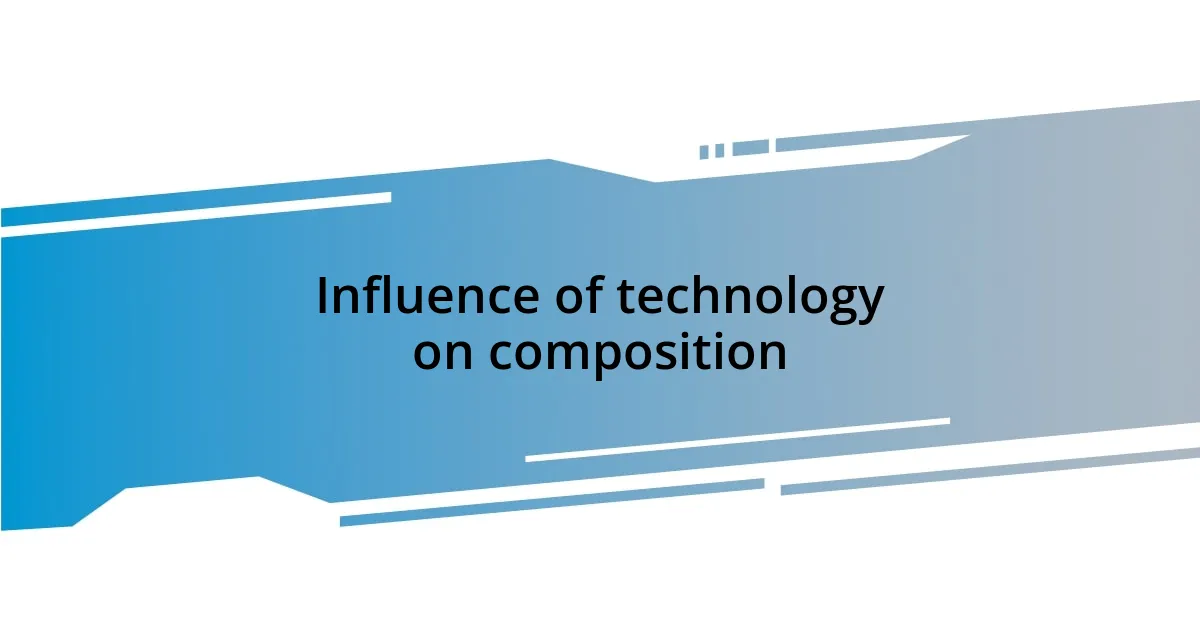
Influence of technology on composition
The influence of technology on composition is striking and multifaceted. I recall the first time I experimented with music software—it opened a new world of possibilities for me. My creativity surged as I could manipulate sounds and layers in ways that traditional methods wouldn’t allow. Technology has turned composition into an accessible playground where even the most complex soundscapes can be crafted with a few clicks.
Here are some key ways technology has changed the landscape of composition:
-
Digital Audio Workstations (DAWs): Programs like Ableton Live and Logic Pro enable composers to arrange and edit music effortlessly. I often find myself whisked away in their vast libraries of sounds that enrich my compositions.
-
Sampling: The use of recorded sounds to create new music has led me to discover innovative textures in my pieces, and I find inspiration in everyday sounds around me.
-
Collaboration tools: Online platforms allow musicians to work together despite geographical barriers, enabling cross-pollination of ideas that fuels the modern classical music scene.
-
Virtual instruments: Software synthesizers and sampled orchestras have made high-quality orchestration accessible to composers without access to a full ensemble, allowing for unique compositions that were once just dreams.
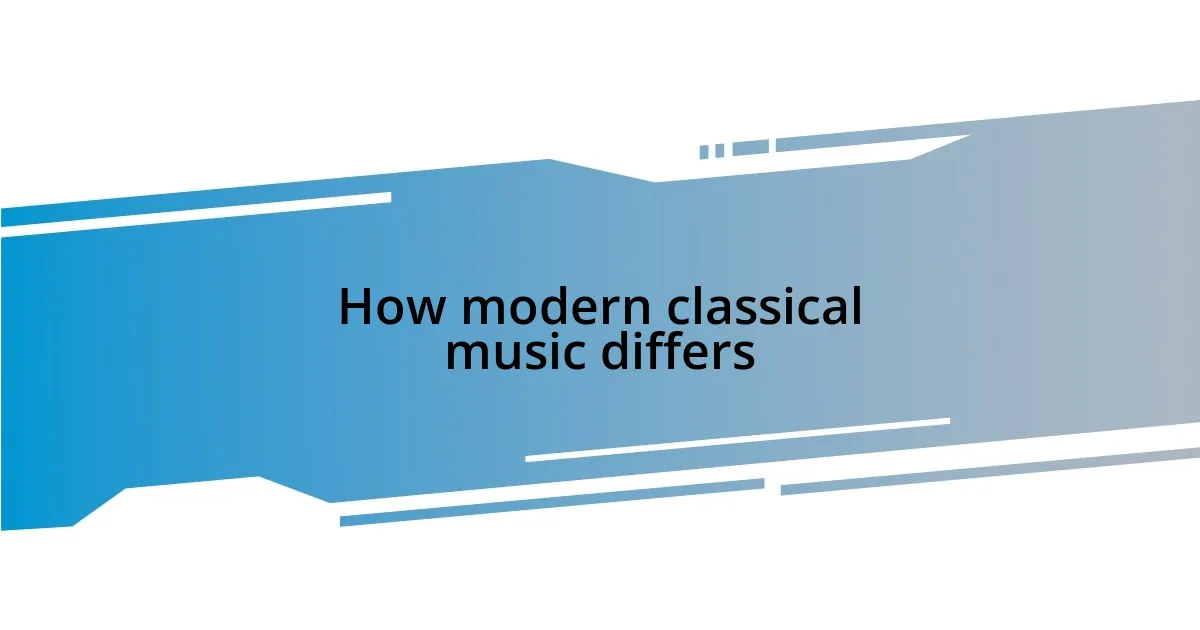
How modern classical music differs
Modern classical music truly sets itself apart in its embrace of diverse influences. Unlike traditional classical music, where strict forms and established rules reign, today’s composers draw from a vast array of styles, including jazz, pop, and even world music. I recall a performance where a symphony incorporated beatboxing artists; it was mind-bending and exhilarating, showcasing a freedom of expression that’s both refreshing and innovative.
The way modern classical music engages with emotionality is also distinctive. Many contemporary pieces focus on raw emotions rather than structured narratives. In one concert, I was moved by a piece that captured the essence of joy and sorrow simultaneously, expressed through fluctuating dynamics and unusual chord progressions. This continuous exploration of the emotional spectrum encourages listeners to connect with the music on personal levels—it’s like a conversation that evolves.
The relationship between silence and sound is another defining feature of modern classical music. Composers today often use silence as a powerful element, creating tension and anticipation within a piece. I vividly remember being utterly captivated during a performance where the use of silence punctuated the music, leaving the audience in a state of contemplation. This deliberate manipulation invites us to listen more deeply, transforming the listening experience into something profound and introspective.
| Feature | Traditional Classical Music | Modern Classical Music |
|---|---|---|
| Structure | Strict forms and lengthy compositions | Free-form; blends various genres |
| Emotional Expression | Narrative-driven and thematic | Raw emotions with abstract themes |
| Use of Silence | Minimal; often overshadowed by sound | Integral to building tension and depth |
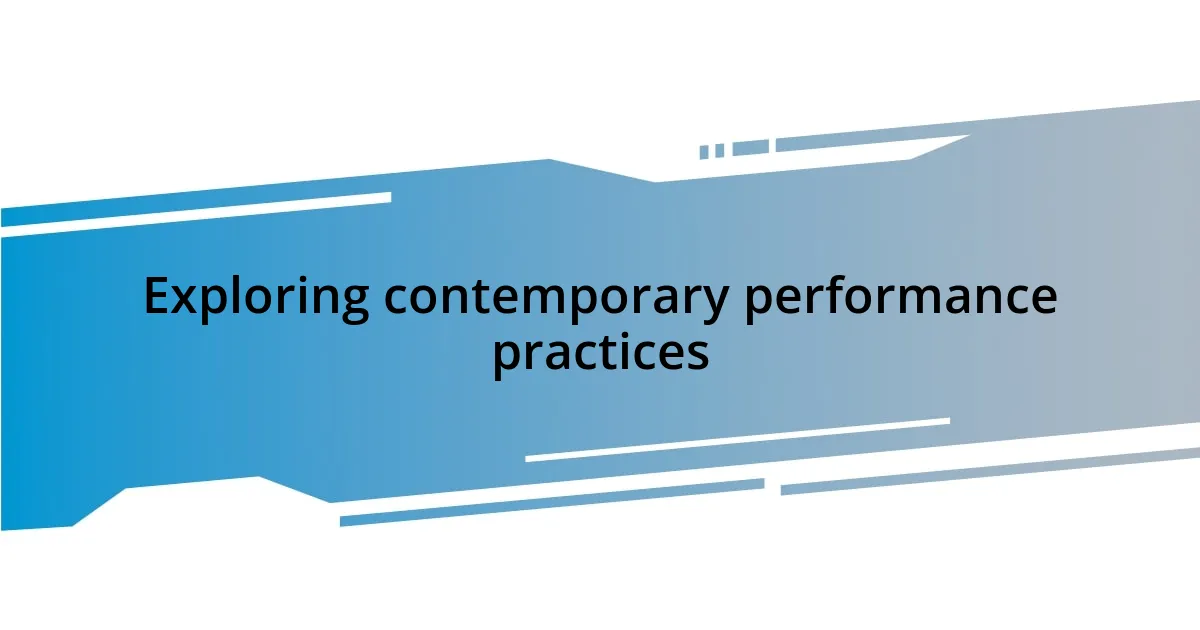
Exploring contemporary performance practices
Exploring contemporary performance practices reveals an exciting intersection between traditional techniques and innovative methods. I remember attending a concert where performers utilized unconventional spaces, like warehouses and outdoor environments, to create immersive experiences. It got me thinking—how does the space influence the perception of sound? The reverberations and acoustics of a large, empty room can transform a simple piano melody into a soul-stirring experience.
Another fascinating aspect is the integration of multimedia elements in performances. One time, I witnessed a string quartet accompanied by stunning visual projections that mirrored the emotional journey of the music. It was a revelation for me to see how visuals can amplify the narrative, inviting the audience to engage on a deeper level. I often ponder how such synergy between the auditory and visual opens up new avenues for storytelling in music.
Moreover, the spontaneity of improvisation in modern performances adds an exhilarating layer of unpredictability. I’ve had my breath taken away during a live show when a musician deviated from the sheet music, leading to a breathtakingly raw moment of creativity. It begs the question: does this spontaneous approach change our expectations from classical music? I believe it brings us closer to the essence of what music truly is—a living, breathing art form that thrives on the unexpected.
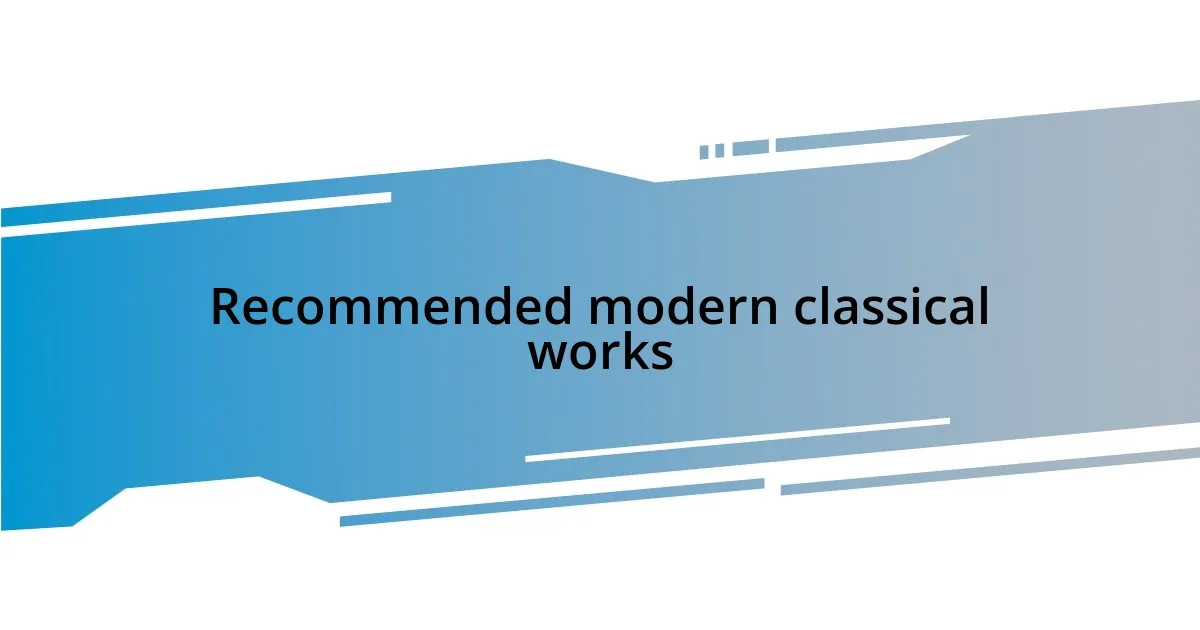
Recommended modern classical works
When I think about modern classical works, one piece that stands out is Max Richter’s Sleep. This immersive composition lasts eight hours and is designed to be listened to while sleeping. The first time I experienced it, I felt a profound sense of tranquility wash over me. It’s fascinating how music can bridge our waking and dreaming worlds, don’t you think?
I can’t help but recommend Ólafur Arnalds’ re:member as another modern gem. Its blend of strings, piano, and electronics creates a beautiful, atmospheric soundscape that resonates deeply with listeners. At one concert, I found myself floating in this emotional space where the delicate melodies intertwined with my thoughts, reminding me of the fleeting nature of time. Isn’t it incredible how a singular moment in music can evoke such a deep introspection?
Lastly, Philip Glass’s The Hours is a work that continually captivates me. The repetitive patterns and minimalist style offer a unique lens through which to explore everyday life. I remember sitting in the audience, feeling as if each note was peeling back layers of my own daily experiences. It’s amazing how music can act as a mirror, reflecting our inner lives while taking us on a journey through sound. Wouldn’t you agree that the nuances in these modern compositions speak volumes about our shared human experience?

